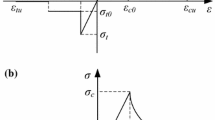Abstract
A large number of tests have recently been conducted with the Split Hopkinson pressure bar (SHPB) method to determine the characteristics of rock dynamics. However, it is still impossible to get test results at a perfect constant strain rate from this set-up owing to the rate dependency of rock materials. For instance in most cases, dynamic behavior of rock can only be described with an average strain rate. The results from these methods, including rich strain rate information, frequently tend to be inexplicable or self-contradictory. The obtained stress–strain curves can then never be directly treated as constitutive curves as in static tests. In this paper, the reasons behind the controversial stress–strain results with current methods are analyzed. In addition, the requirement for the rock specimen to deform at a constant strain rate is demonstrated after theoretical analysis of correlations among specimen, deforming stress, incident stress, reflected stress and transmitted stress. With test results from SHPB by pulse shaper and special shape striker methods, the requirement is verified. Finally, the method of 3D scattergram considering stress–strain–strain rate simultaneously is brought up to get constitutive relationships of rate-dependent rock. The new method gives reasonable predictions for constitutive relationships of rock at different strain rates. At the same time, the new method has fewer requirements and has a wider application scope for SHPB tests.
















Similar content being viewed by others
References
ASM Int (2000) High strain rate testing, ASM handbook, vol 8, Mechanical Testing and Evaluation, Materials Park OH, pp 939–1269
Cho SH, Ogata Y, Kaneko K (2003) Strain-rate dependency of the dynamic tensile strength of rock. Int J Rock Mech Min Sci 40(5):763–777
Ellwood S, Griffiths LJ, Parry DJ (1982) Materials testing at high constant strain rates. J Phys E Sci Instrum 15(3):280–282
Field JE, Walley SM, Proud WG et al (2004) Review of experimental techniques for high rate deformation and shock studies. Int J Impact Eng 30(7):725–775
Frantz CE, Follansbee PS, Wright WJ (1984) New experimental techniques with the split Hopkinson pressure bar. In: Berman I, Schroeder JW (eds) Proc 8th Int Conf High Energy Rate Fabr, San Antonio, pp 17–21
Frew DJ, Forrestal MJ, Chen W (2002) Pulse shaping techniques for testing brittle materials with a split Hopkinson pressure bar. Exp Mech 42(1):93–106
Kumar A (1968) The effect of stress rate and temperature on the strength of basalt and granite. Geophysics 33(3):501–510
Li JC, Ma GW (2009) Experimental study of stress wave propagation across a filled rock joint. Int J Rock Mech Min Sci 46(3):471–478
Li QM, Meng H (2003) About the dynamic strength enhancement of concrete-like materials in a split Hopkinson pressure bar test. Int J Solids Struct 40(2):343–360
Li XB, Lok TS, Zhao J (2000) Oscillation elimination in the Hopkinson bar apparatus and resutant complete dynamic stress-strain curves for rocks. Int J Rock Mech Min Sci 37(7):1055–1060
Li XB, Lok TS, Zhao J (2005) Dynamic characteristics of granite subjected to intermediate loading rate[J]. Rock Mech Rock Eng 38(1):21–39
Li XB, Zhou ZL, Lok TS et al (2008) Innovative testing technique of rock subjected to coupled static and dynamic loads. Int J Rock Mech Min Sci 45(5):739–748
Liu DS, Peng YD, Li XJ et al (1998) Inverse design and experimental study of impact piston. Chin J Mech Eng 34(4):78–84 (in Chinese)
Okubo S, Nishimatsu Y, He C (1990) Loading rate dependence of class II rock behavior in uniaxial and traxial compression tests—an application of a proposed new control method. Int J Rock Mech Min Sci Geomech Abstr 27(6):559–562
Tao JL, Tian CJ, Cheng YZ et al (2004) Investigation of experimental method to obtain constant strain rate of speciemen in SHPB. Explos Shock Waves 24(5):413–418 (in Chinese)
Tedesco JW, Ross CA (1998) Strain-rate dependent constitutive equations for concrete. J Press Vessel Technol Trans ASME 120(4):398–405
Wang QZ, Li W, Xie HP (2009) Dynamic split tensile test of Flattened Brazilian Disc of rock with SHPB setup. Mech Mater 41(3):252–260
Xia K, Nasseri MHB, Mohanty B et al (2008) Effects of microstructures on dynamic compression of Barre granite. Int J Rock Mech Min Sci 45(6):879–887
Yang LM, Shim VPW (2005) An analysis of stress uniformity in split Hopkinson bar test specimens. Int J Impact Eng 31(2):129–150
Zhou ZL, Li XB, Zou YJ et al (2006) Fractal characteristics of rock fragmentation at strain rate of 100–102 s−1. J Cent South Univ Technol 13(3):290–295
Zhou ZL, Ma GW, Li XB (2007) Dynamic brazilian splitting and spalling tests for granite. In: Sousa LR, Olalla C, Grossmann NF (eds) Proc 11th Congress of the ISRM2007, vol 1, Lisbon, pp 1127–1130
Zhu WC (2008) Numerical modeling of the effect of rock heterogeneity on dynamic tensile strength. Rock Mech Rock Eng 41(5):771–779
Acknowledgments
Financial support from the National Natural Science Foundation of China (50904079, 50934006) and PhD Programs Foundation of Chinese Education Ministry (200805331143) are greatly acknowledged. Our thanks are due to Prof Jian Zhao at Swiss Federal Institute of Technology Lausanne and Prof Richard Durham at the University of Western Australia for their help in the improvement of the paper. Also, the authors express their acknowledgements to the anonymous reviewers for their precious comments.
Author information
Authors and Affiliations
Corresponding author
Rights and permissions
About this article
Cite this article
Zhou, Z., Li, X., Ye, Z. et al. Obtaining Constitutive Relationship for Rate-Dependent Rock in SHPB Tests. Rock Mech Rock Eng 43, 697–706 (2010). https://doi.org/10.1007/s00603-010-0096-3
Received:
Accepted:
Published:
Issue Date:
DOI: https://doi.org/10.1007/s00603-010-0096-3




